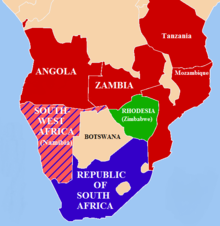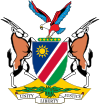حرب الاستقلال الناميبية
| حرب الاستقلال الناميبية | |||||||||
|---|---|---|---|---|---|---|---|---|---|
| جزء من الحرب الباردة وحرب الحدود الجنوب أفريقية | |||||||||
 Geopolitical situation, 1978. States friendly to the nationalist guerrillas are denoted in red, and Namibia itself presented in a maturing pink. | |||||||||
| |||||||||
| المتحاربون | |||||||||
|
قوات مناهضة للشيوعية: |
قوات وطنية أفريقية : | ||||||||
| القادة والزعماء | |||||||||
|
|
| ||||||||
| القوى | |||||||||
|
~71,000 (1989)[1][17] |
| ||||||||
| الضحايا والخسائر | |||||||||
| 2,038[19] – 2,500[20] | 11,335[21] | ||||||||
جزء من سلسلة عن |
|---|
| تاريخ ناميبيا |
 |
حرب الاستقلال الناميبية, which lasted from 1966 to 1990 and gained independence for the country, was a guerrilla war which the nationalist South-West Africa People's Organization (SWAPO) and others fought against the apartheid government of South Africa. It had occupied and controlled the territory since 1915, during World War I. This independence movement was closely intertwined مع حرب الحدود الجنوب أفريقية.
South Africa had administered what was then still known as South West Africa since it captured the German territory in 1915 during الحرب العالمية الأولى. وقد حصلت على انتداب عصبة الأمم في 1920 (عبر المملكة المتحدة) لادارة الإقليم.
. . . . . . . . . . . . . . . . . . . . . . . . . . . . . . . . . . . . . . . . . . . . . . . . . . . . . . . . . . . . . . . . . . . . . . . . . . . . . . . . . . . . . . . . . . . . . . . . . . . . . . . . . . . . . . . . . . . . . . . . . . . . . . . . . . . . . . . . . . . . . . . . . . . . . . . . . . . . . . . . . . . . . . . .
انظر ايضاً
- حرب الحدود الجنوب أفريقية
- الحرب الأهلية الأنگولية
- South West African Territorial Force
- South West African Police
- Koevoet
الهامش
- ^ أ ب Fryxell, Cole. To Be Born a Nation. p. 13.
- ^ Cuba Annual Report: 1986, 1986. Page 538-539.
- ^ Land Mines in Angola, 1993. Page 6.
- ^ The Soviet Union and Revolutionary Warfare: Principles, Practices, and Regional Comparisons, 1988. Page 140-147
- ^ Namibia: The Road to Self-government, 1979. Page 41.
- ^ The Foreign Policy of Yugoslavia, 1973–1980, 1980. Page 125
- ^ Yugoslavia in the 1980s, 1985. Page 265.
- ^ Interparliamentary Union Conference, Sofia, Bulgaria: Report of the United States Delegation to the 64th Conference of the Interparliamentary Union, Held at Sofia, Bulgaria, 21–30 September 1977. Page 42
- ^ Record of Proceedings -International Labour Conference 6, 1982. Page 4.
- ^ Tanzania: A Political Economy, 2013. Page 355.
- ^ SWAPO and the Struggle for National Self-determination in Namibia, 1980. Page 33.
- ^ "Rhodesian Insurgency – Part 2". Rhodesia.nl. Retrieved 15 January 2013.
- ^ Imagery and Ideology in U.S. Policy Toward Libya 1969–1982, 1988. Page 70.
- ^ SWAPO Information Bulletin," 1983. Page 37.
- ^ AAPSO Presidium Committee on Africa held in Algeria, 17–18 February 1985, 1985. Page 26.
- ^ David A. Granger. "Forbes Burnham and the Liberation of Southern Africa" (PDF). Retrieved 1 August 2015.
- ^ Tsokodayi, Cleophas Johannes. Namibia's Independence Struggle: The Role of the United Nations. pp. 1–305.
- ^ "World Bank discussion paper no. 331: Africa technical department series : Case". Greenstone. 1996. Retrieved 9 August 2013.
- ^ "SA Roll of Honour: List of Wars". Justdone.co.za. Retrieved 15 January 2013.
- ^ Reginald Herbold Green. "Namibia : The road to Namibia – Britannica Online Encyclopedia". Britannica.com. Retrieved 15 January 2013.
- ^ "Military Chronicle of South-West Africa". Rhodesia.nl. Retrieved 15 January 2013.
وصلات خارجية
- Articles with hatnote templates targeting a nonexistent page
- Portal-inline template with redlinked portals
- Pages with empty portal template
- جنوب غرب أفريقيا
- حرب الحدود الجنوب أفريقية
- نزاعات الحرب الباردة
- الحرب الباردة في أفريقيا
- نزاعات القرن العشرين
- التاريخ العسكري لناميبيا
- تاريخ ناميبيا
- حروب استقلال
- Guerrilla wars
- تمردات في أفريقيا
- العلاقات الجنوب أفريقية الناميبية
- سواپو
- حروب أنگولا
- حروب كوبا
- حروب ناميبيا
- حروب جنوب أفريقيا
- سام نوجوما